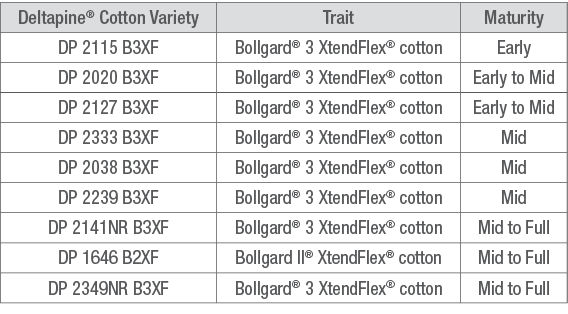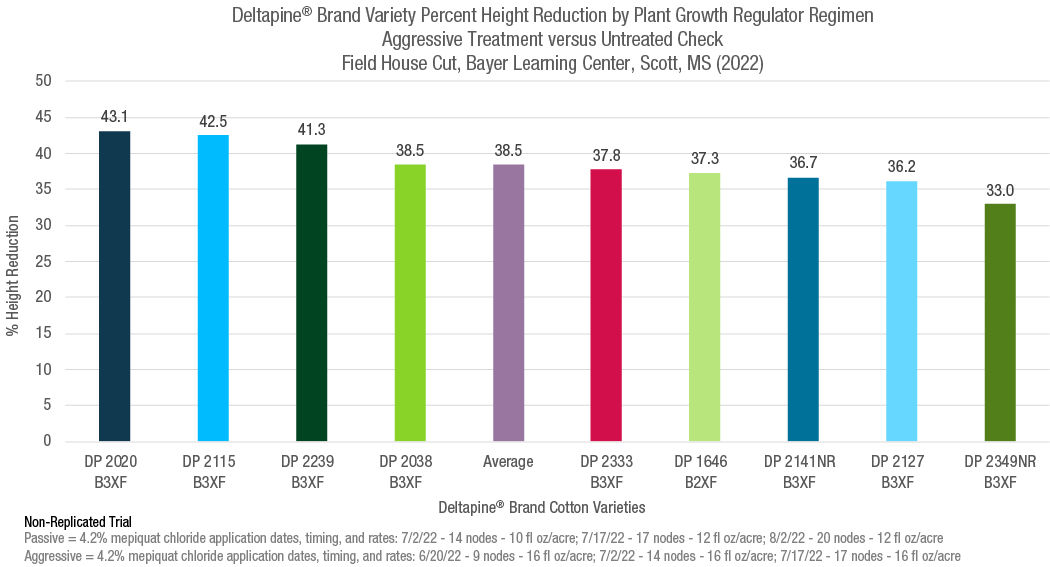20 MIN READ
Response of Deltapine® Brand Cotton Varieties to Different Plant Growth Regulator (PGR) Regimens
March 21, 2023
To compare yearly data, click on a tab.
Response of Deltapine® Brand Cotton Varieties to Different Plant Growth Regulator (PGR) Regimens - 2022
Trial Objective
- The objective of this study at the Bayer Learning Center at Scott, MS was to evaluate the response of Deltapine® brand cotton varieties to different plant growth regulator (PGR) regimens.
- Cotton PGR response is an important characteristic to consider when selecting a cotton variety to plant.
- The goal of this study is to increase information for managing Deltapine® cotton varieties.
- Proper PGR management helps optimize Deltapine® cotton variety return on investment potential.
Research Site Details
- All weed, insect, and agronomic inputs were per local recommendations except PGR applications.
- 110 lb/acre of nitrogen (N) was applied as 28-0-0-4 (N-P-K-S) before layby.
- PGR Regimens:
- Untreated Check (UTC) - no PGR applied.
- Passive Regimen – Represents a more passive PGR treatment, which was typically applied two weeks later and at reduced application rates compared to aggressive treatments.
- Application dates, timing, and rates for 4.2% mepiquat chloride:
- 7/2/2022 - 14 nodes - 10 fl oz/acre.
- 7/17/2022 - 17 nodes - 12 fl oz/acre.
- 8/2/2022 - 20 nodes - 12 fl oz/acre.
- Application dates, timing, and rates for 4.2% mepiquat chloride:
- Aggressive Regimen – PGR applications that are aggressive biologically and within labelled rates which usually begin at 8 to 9 nodes.
- Application dates, timing, and rates for 4.2% mepiquat chloride:
- 6/20/2022 - 9 nodes - 16 fl oz/acre.
- 7/2/2022 - 14 nodes - 16 fl oz/acre.
- 7/17/2022 - 17 nodes - 16 fl oz/acre.
- Application dates, timing, and rates for 4.2% mepiquat chloride:
- Trial was a single replicate (0.15 acre/plot) treatment, machine harvested, and site turnouts (from adjacent experiments) were used to estimate lint yields.
- Table 1 includes the cotton varieties, traits, and maturities planted.
Table 1. Deltapine® cotton varieties planted in trial.

| Location | Scott, MS |
| Soil Type | Commerce Sandy Loam |
| Previous Crop | Corn |
| Tillage Type | Conventional |
| Planting Date | 4/29/22 |
| Harvest Date | 9/20/22 |
| Potential Yield (bu/acre) | 2000 |
| Seeding Rate (seeds/acre) | 42,000 |
Understanding the Results
- The 2022 growing season for cotton was very harsh early in the season but followed by good growing conditions. The characteristics of the season included:
- On time planting.
- A wet early season leading to an average early fruit set in all tested varieties.
- After the early rains ended, cotton crops at the Learning Center began to fruit normally and ultimately had very good yield potential.
- Data from 2022 shows a similar response to previous years but requires a somewhat different interpretation.
- Plant Heights - Across the varieties tested, the passive plots showed a height reduction of 18.7 inches (26.3%) while the aggressively treated plots showed an average height reduction of 27.3 inches (38.5%) versus the UTC plots (Figures 1 and 2). This is typical for previous years.


- Lint Yield – The UTC plots averaged 1668 lb lint/acre (Figure 3). This improved to an average of 1776 lb lint/acre (108.2 lb/acre or 6.1% increase) in the passively managed plots and an average of 1782 lb lint/acre (114 lb/acre or 6.4% increase) in the aggressively managed plots (Figure 3).

- Growing conditions, fruiting, and PGR effects on plant height:
- Like 2021, 2022 had unique growing conditions and discussions of interactions with those conditions are necessary for correct data interpretation.
- Yields in the study, across all varieties and treatments were extremely high.
- Yields were very good for most of the cotton experiments at the learning center this year. Results were characterized by high fruit retention, limited fruit shed, and little to no boll rot.
- The varietal height reduction responses to PGR applications were typical versus most years.
- Even though the UTC and passive regimens yielded well, they were very difficult to machine harvest.
- There are other non-yield advantages to proper and timely applied PGR applications and the associated growth control.
- In a typical season, target spot, boll rot, and physiological fruit shed can limit fruiting success and harvestable yield potential.
- Varietal PGR Sensitivity
- Across the range of varieties tested, the earlier varieties, which are typically more determinate, showed an increased response to the aggressive PGR applications as measured by the percent height reduction at harvest.
- The early, more determinate varieties are in the upper half (from the mean) of the varieties when considering the percent height reduction.
- The later, less determinate products are in the lower response range which is typical of previous years data.
- The untreated varieties in the UTC varied from 66.8 to 73.0 to inches in height (Figure 1).
- The aggressively managed treatments ranged from 39.4 to 48.9 inches in height (Figure 1).
- The percent range of height reduction was from 33.01 to 43.14 when comparing the heights (inches) of the aggressive treatments to the UTC (Figure 2).
- This defines the relative response to PGR application across the tested varieties, with Deltapine® DP 2020 B3XF brand being the most sensitive and Deltapine® DP 2349NR B3XF brand being least sensitive to the intensity (in rate and timing) of PGR usage.
- The results support the need for the specific management of individual fields and varieties.
- Across the range of varieties tested, the earlier varieties, which are typically more determinate, showed an increased response to the aggressive PGR applications as measured by the percent height reduction at harvest.
- Return on Investment (ROI)
- This is an important consideration when managing cotton varieties with PGR.
- The components to determine ROI are different, hard to measure, and can each impact ROI greatly.
- Plant height
- Excessively tall cotton plants are difficult to machine harvest.
- Value is difficult to measure, but very important.
- Machine efficiency can be greatly affected by excess plant volume.
- Picking becomes slower, less efficient, and costly.
- Excessively tall cotton plants are difficult to machine harvest.
- Disease risk
- In many production seasons, the effects of boll rot and target spot can be exacerbated by excess growth; however, there was little to no boll rot and minor effects from target spot in 2022.
- Potential observed yield loss from these factors has been as much as 50 percent in rank cotton.
- Yield
- The average yield response to a PGR application across the regimens in this study was 111 lb/acre.
- In different growing conditions the response can vary greatly.
- Parameters used for calculating ROI:
- Cost of mepiquat chloride = $0.08/fl oz.
- The average PGR applied across the two regimens = 41 fl oz/acre.
- The market price of cotton lint = $0.90/lb.
- Each PGR application was $7.00/acre for the 3 applications ($21.00 in total).
- The gross return using these parameters = $99.90/acre.
- Calculation
- The cost to apply the PGR products is:
- $21.00 (application cost) + $3.28 (41 fl oz of mepiquat chloride/acre) = total cost of $24.28/acre for the season.
- $99.90 (gross return) - $24.28/acre (cost) = an ROI response of $75.62/acre for using the PGR products appropriately in cotton.
- The cost to apply the PGR products is:
- Plant height
Key Learnings
- In response to the applied PGR regimens in the study, the tested products responded as expected in height reduction and showed improvements in yield potential.
- PGR response and applications remain very important factors when considering a cotton variety to plant for 2023.
- Each variety, field, farm, and agronomic case should be managed individually.
- Please contact your local Bayer representative for more details.
1420_180128